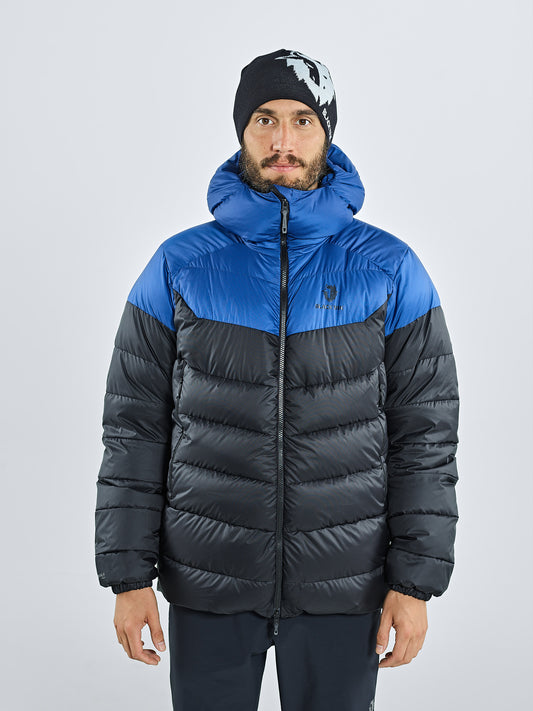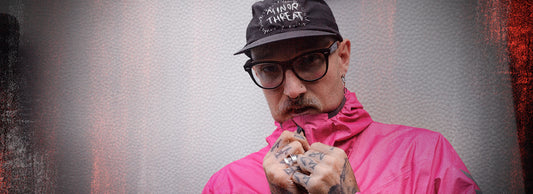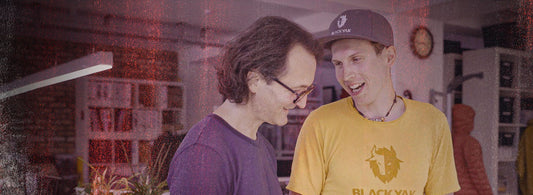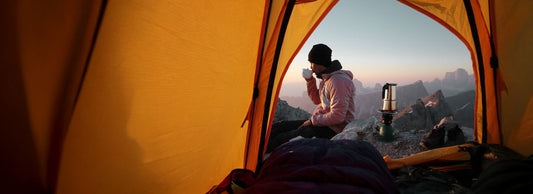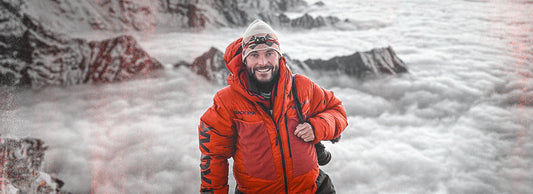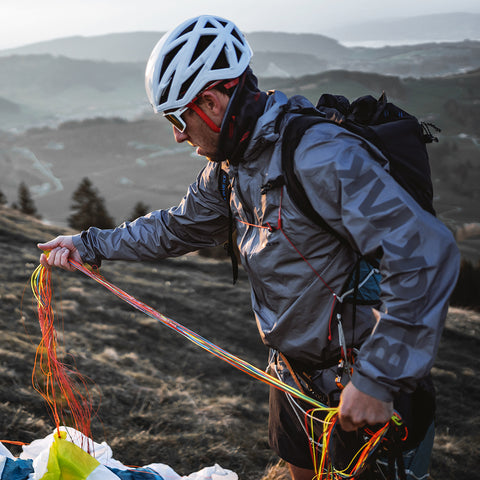On April 20, 2023, a true miracle happened in the Annapurna Mountains. Our BLACKYAK athlete, Adam Bielecki and a group of Sherpas rescued a lost Indian climber.
Annapurna
Of the 14 eight-thousanders, Annapurna is the tenth highest at 8,091 meters, but also one of the most dangerous mountains in the world.

On April 5, 2023, the climbers Mariusz Hatala and Adam Bielecki started the ascent of Annapurna. At the beginning via the normal route, then they tried to open a new route in alpine style on the northwest face of Annapurna. On April 16 and 17, this plan became concrete, and they climbed from base camp (BC) to advanced base camp (ABC). Unfortunately, they did not get further than 6,200 m, as constant rockfall threatened their continued ascent. After Adam Bielecki was hit by a rock on his helmet, they decided to descend. On April 18, they were back safe at base camp.

On April 17, 2023, Indian climber Anurag Maloo and his teammates became distressed while descending from Camp 3 after a failed attempt to climb Annapurna. They were rescued on April 18, a day after the incident.
Maloo, however, remained missing.
The tireless efforts of Maloo's family and the Indian government convinced the Nepalese government to launch a rescue operation. Seven Summits Trek, Nepal's largest mountaineering tour operator, sent a Sherpa rescue team to Annapurna. They found Maloo; he had fallen into a crevasse between Camp 3 and Camp 2. However, rescue was impossible for the Sherpa team as Maloo was lying unconscious in the middle of a 60 meter deep crevasse. Dawa Nurbu Sherpa, of Seven Summits Trek, asked Bielecki's team, which was at base camp at the time, to join in the rescue of Maloo.
Crevasse rescues are complex and dangerous. Unlike normal mountain rescues, it is a complex process that involves descending a deep crevasse and pulling out a person weighing up to 80 kilograms. This requires not only climbing skills, but also crevasse rescue systems, equipment and many people helping. Multiple pieces of equipment and ropes are combined to create a "pulley system," which can be dangerous for both, the rescuer and the person being rescued. Even experienced climbers are rarely able to understand and perform such a complex rescue system.

April 20, 2023

Early in the morning, the rescue team, led by Adam Bielecki, flew by helicopter to the accident site. After a 30-minute ride, they arrived at the crevasse. Bielecki was the first to descend into the crevasse and discovered the snow-covered Maloo at the end of his 60-meter rope. When Bielecki spotted Maloo, he thought it would be a body retrieval. Maloo was immobile and probably no longer alive.

As Bielecki approached Maloo, he was surprised and pleased to see that he was still breathing, and his eyes were responding to the light. The body recovery turned into a rescue operation.

Maloo was unconscious and severely hypothermic, so the rescue had to be quick.
Tashi Sherpa, who was waiting outside the crevasse, descended into the crevasse. Bielecki and Tashi Sherpa had to hurry with the rescue before Maloo's body temperature dropped further. Outside the crevasse, Bielecki's colleague, Mariusz Hatala prepared a pulley system with pulleys and carabiners to pull Maloo up. The ropes were secured with ice screws to be able to pull him up.

Lifting a person from a 60-meter crevasse requires a great deal of physical strength and poses a high level of risk. Hatala and four Sherpas slowly pulled Maloo up by rope. In the crevasse, Bielecki aligned Maloo's body so that he would not get caught in the rocks and snow. The perilous rescue took more than an hour before Maloo was finally pulled out of the crevasse.

The rescue team quickly took him to the helicopter and after less than an hour he reached the hospital in Pokhara.
Although Anurag Maloo could be saved, his condition was critical. He was saved by cardiopulmonary resuscitation and first aid measures by the medical team.

This was not the first rescue operation Adam Bielecki was involved in. In 2018, he was on K2 in Pakistan with a group of fellow climbers. The team of world-class climbers was aiming to make the world's first winter ascent of K2.
When Bielecki and Urubko heard about an emergency on Nanga Parbat, they set off from K2 without hesitation.
The winter ascents of K2 and Nanga Parbat are extremely difficult. K2 had never allowed anyone to climb it in winter before (2018), so they were the only climbers around who could rescue climbers in distress on Nanga Parbat.
When they arrived at Nanga Parbat in a Pakistani military helicopter, they were able to quickly ascend and rescue French climber Elisabeth Revol in the darkness. The rescue was risky as the team had to deal with strong winds, cold and darkness.
Taking risks
What does a rescue on the highest mountains in the world mean?
It takes a lot of courage and sacrifice to rescue someone in everyday life, but especially in the unpredictable mountains of the Himalayas. In the Himalayas, the dangers are not comparable to everyday life. Often rescuers expose themselves to great danger to save missing or distressed people.
Climbing in the Himalayas is a costly endeavor. Mountaineers spend years preparing, funding, and training to climb peaks in the Himalayas. On a Himalayan expedition, where reaching the summit is the goal, a rescue mission can be tantamount to giving up.
In the oxygen-deprived Himalayas, rescue operations take a tremendous toll on fitness, which is not easily restored. In the end, the climb is likely to be a failure. All of Bielecki's Himalayan expeditions failed after rescue operations.
Rescues are also complicated and dangerous when descending after reaching the summit. If the accident occurs above 7000 meters, the person to be rescued and the rescuer are exposed to great danger. It is almost impossible to rescue an injured person above 7000 meters in the descent, if he has used up all his energy reaching the summit. The ascent is difficult, but the descent is even more difficult.
Saving others in the Himalayas means putting your own life on the line.

From April 17 to April 20, 2023, the following people worked to save Indian climber Anurag Maloo:
Adam Bielecki, Mariusz Hatala, Chhepal Sherpa, Lakpa Nurbu Sherpa, Dawa Nurbu Sherpa, Lakpa Sherpa, Tashi Sherpa, coordinated from the base camp by Chhang Dawa Sherpa, Sobit Gauchan - rescue pilot.
Bielecki did not hesitate in the accidents he encountered in the Himalayas: his courage and sacrifice ensured that those in distress were rescued and returned to their families.
We wish Maloo, who survived three days in the crevasse, a full recovery.
-
MEN'S MANDU HOODED EXPEDITION DOWN JACKET
The secret to its incredible performance lies inside the MANDU HOODED EXPEDIT...Regular price 980,00 €Regular priceUnit price per



